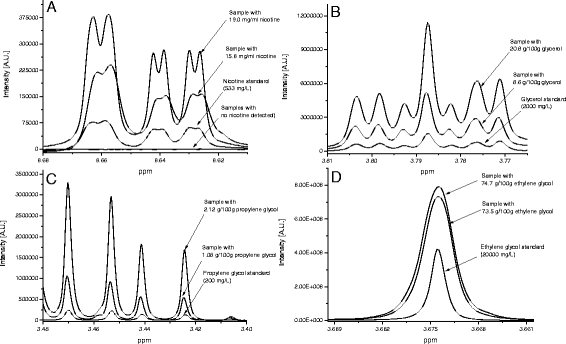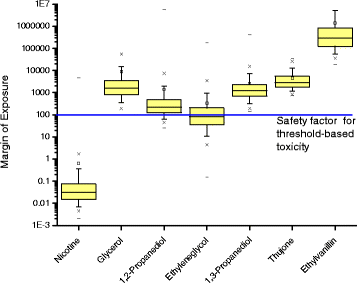Electronic cigarettes: overview of chemical composition and exposure estimation
- PMID: 25620905
- PMCID: PMC4304610
- DOI: 10.1186/s12971-014-0023-6
Electronic cigarettes: overview of chemical composition and exposure estimation
Abstract
Background: Electronic cigarettes (e-cigarettes) are advertised to tobacco users as a tool to decrease cigarette consumption and to reduce toxic exposure associated with conventional tobacco smoking. Little is known about the compounds contained in such products, their exposure and long-term health effects.
Methods: NMR spectroscopy was used to ascertain the content of several constituents of e-cigarette liquids including nicotine, solvents and some bioactive flavour compounds. Risk assessment was based on probabilistic exposure estimation and comparison with toxicological thresholds using the margin of exposure (MOE) approach.
Results: In 54 samples of e-cigarette liquids, the average nicotine content was 11 mg/ml. Only 18 from 23 samples were confirmed as nicotine-free samples and in one e-cigarette liquid nicotine was not detected while being declared on the labelling. Major compounds of e-cigarette liquids include glycerol (average 37 g/100 g), propylene glycol (average 57 g/100 g) and ethylene glycol (average 10 g/100 g). Furthermore, 1,3-propanediol, thujone and ethyl vanillin were detected in some samples. The average exposure for daily users was estimated as 0.38 mg/kg bw/day for nicotine, 8.9 mg/kg bw/day for glycerol, 14.5 mg/kg bw/day for 1,2-propanediol, 2.1 mg/kg bw/day for ethylene glycol, and below 0.2 mg/kg bw/day for the other compounds. The MOE was below 0.1 for nicotine, but all other compounds did not reach MOE values below 100 except ethylene glycol and 1,2-propanediol.
Conclusions: NMR spectroscopy is a useful and rapid method to simultaneously detect several ingredients in e-cigarette liquids. From all compounds tested, only nicotine may reach exposures that fall into a high risk category with MOE <1. Therefore, e-cigarette liquid products should be subjected to regulatory control to ensure consistent nicotine delivery. Solvents with more favourable toxicological profiles should be used instead of ethylene glycol and 1,2-propanediol, which may fall into a risk category with MOE < 100.
Keywords: Electronic cigarettes; Electronic nicotine delivery systems; Nicotine; Risk assessment.
Figures



References
-
- Farsalinos KE, Romagna G, Allifranchini E, Ripamonti E, Bocchietto E, Todeschi S, Tsiapras D, Kyrzopoulos S, Voudris V. Comparison of the cytotoxic potential of cigarette smoke and electronic cigarette vapour extract on cultured myocardial cells. Int J Environ Res Public Health. 2013;10:5146–5162. doi: 10.3390/ijerph10105146. - DOI - PMC - PubMed
-
- Romagna G, Allifranchini E, Bocchietto E, Todeschi S, Esposito M, Farsalinos KE. Cytotoxicity evaluation of electronic cigarette vapor extract on cultured mammalian fibroblasts (ClearStream-LIFE): comparison with tobacco cigarette smoke extract. Inhal Toxicol. 2013;25:354–361. doi: 10.3109/08958378.2013.793439. - DOI - PubMed
LinkOut - more resources
Full Text Sources
Other Literature Sources

